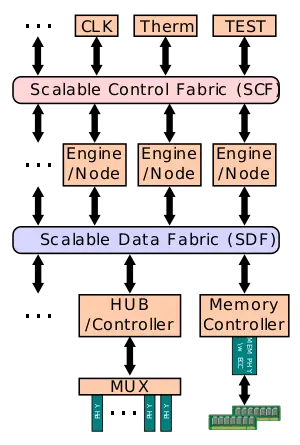| Line 1: | Line 1: | ||
{{amd title|Infinity Fabric}}[[File:amd infinity fabric.svg|right|300px]] | {{amd title|Infinity Fabric}}[[File:amd infinity fabric.svg|right|300px]] | ||
| − | '''Infinity Fabric''' ('''IF''') is a system of transmissions and controls that underpin | + | '''Infinity Fabric''' ('''IF''') is a system of transmissions and controls that underpin [[AMD]]'s recent microarchitectures for both CPU (i.e., {{amd|Zen|l=arch}}) and graphics (e.g., {{amd|Vega|l=arch}}), and any other additional accelerators they might add in the future. The interconnections were first announced and detailed in April 2017 by Mark Papermaster, AMD's SVP and CTO. |
The Infinity Fabric consists of two separate communication interconnections: Infinity '''Scalable Data Fabric''' ('''SDF''') and the Infinity '''Scalable Control Fabric''' ('''SCF'''). The SDF is the primary means by which data flows around the system between end point (e.g. [[NUMA node]]s, [[PHY]]s). The SDF might have dozens of connecting points hooking together things such as [[PCIe]] PHYs, [[memory controller]]s, USB hub, and the various computing and execution units. The SDF is a [[superset]] of what was previously [[HyperTransport]]. The SCF handles the transmission of the many miscellaneous system control signals - this includes things such as thermal and power management, tests, security, and 3rd party IP. With those two interconnections, AMD can efficiently scale up many of the basic computing blocks. | The Infinity Fabric consists of two separate communication interconnections: Infinity '''Scalable Data Fabric''' ('''SDF''') and the Infinity '''Scalable Control Fabric''' ('''SCF'''). The SDF is the primary means by which data flows around the system between end point (e.g. [[NUMA node]]s, [[PHY]]s). The SDF might have dozens of connecting points hooking together things such as [[PCIe]] PHYs, [[memory controller]]s, USB hub, and the various computing and execution units. The SDF is a [[superset]] of what was previously [[HyperTransport]]. The SCF handles the transmission of the many miscellaneous system control signals - this includes things such as thermal and power management, tests, security, and 3rd party IP. With those two interconnections, AMD can efficiently scale up many of the basic computing blocks. | ||
Revision as of 19:34, 21 June 2017
Infinity Fabric (IF) is a system of transmissions and controls that underpin AMD's recent microarchitectures for both CPU (i.e., Zen) and graphics (e.g., Vega), and any other additional accelerators they might add in the future. The interconnections were first announced and detailed in April 2017 by Mark Papermaster, AMD's SVP and CTO.
The Infinity Fabric consists of two separate communication interconnections: Infinity Scalable Data Fabric (SDF) and the Infinity Scalable Control Fabric (SCF). The SDF is the primary means by which data flows around the system between end point (e.g. NUMA nodes, PHYs). The SDF might have dozens of connecting points hooking together things such as PCIe PHYs, memory controllers, USB hub, and the various computing and execution units. The SDF is a superset of what was previously HyperTransport. The SCF handles the transmission of the many miscellaneous system control signals - this includes things such as thermal and power management, tests, security, and 3rd party IP. With those two interconnections, AMD can efficiently scale up many of the basic computing blocks.
Inter-/Intra- communication
A key feature of the coherent data fabric is that it's not limited to a single die and can extend over multiple dies in an MCP as well as multiple sockets over PCIe links (possibly even across independent systems, although that's speculation). There's also no constraint on the topology of the nodes connected over the fiber, communication can be done directly node-to-node, island-hopping in a bus topology, or as a mesh topology system.
With the implementation of the Infinity Fabric in the Zen microarchitecture, Intra-Chip (i.e. die-to-die) communication over AMD's Global Memory Interconnect has a bi-directional bandwidth of 42.6 GB/s per 4B link. In AMD's EPYC server processor family, which consist of 4 dies, this gives a bisection bandwidth of 170.4 GB/s. Inter-Chip communication (i.e., chip-to-chip such as in the case of a dual-socket server) has a bi-directional bandwidth of 37.9 GB/s for a bisection bandwidth of 151.6 GB/s.
